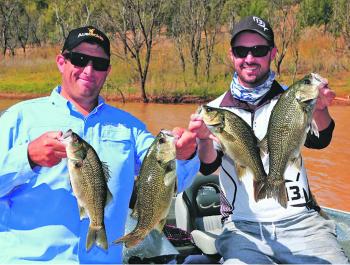January in Hunter Valley can be a dry and dusty time. The hot weather will bring the dam levels down, as evaporation takes place and water is let out to keep the rivers flowing and help irrigation in the lower Hunter. By now the fish will have transitioned into their summer patterns. Lowering water levels and hot water temperatures will drive the majority of fish off the edges. Deep water fishing will be the key to catching numbers of fish during the daylight hours this month.
Lake St Clair with its abundant weed beds will still hold fish during January. There will be a lot of fish out in deep water escaping the heat, but there will also be enough on the edge to still target them. Very early morning and late evening into the night will be the main times to catch some fish around the weed. Surface fishing will still be your best bet to find some active fish. With the dropping water levels, the weed will start to mat on the surface.
These mats will have holes and the edges that create break lines for the fish to hunt along. With a weedless surface lure like a hollow belly frog, weedless plastic or buzzbait, you can easily work these areas. Working your surface lure along the edges and over the holes should produce some fish. Once the sun gets up, try pitching a weedless plastic into these holes or along the edges of the weed. The bigger fish will be in the weed, but once that sun gets up, these fish wise up quick and pretty much get lock jaw. The best bet is to move out deeper and look for schooled fish.
In anywhere from 25-60ft of water you should find fish and you don’t need to find mass amounts either. By slowly sounding around any flats, points or bays, you should find some scattered fish come on the sounder. Once you find these, drop a curl-tail grub down through the fish and you’ll notice more fish that seem to appear from nowhere. Work your plastic straight up and down with a slow wind up and free spool down to the bottom or through the fish. Experiment with different retrieve speeds and even put in a little twitch to see what the fish want.
It will take some patience, but eventually one of these fish will bite. When you get a bite or catch a fish, take notice of what you were doing at the time. This will help you replicate the retrieve and catch you some more fish. Once you have found some deep fish, they can still react to a lure with a stronger action. Blades, tail spinners, deep spinner baits and a jighead rigged beetle spin will work if the plastic isn’t getting a response. Cast these lures through the schools and concentrate on keeping the lure at the depth the fish are holding at.
Lake Glenbawn’s fishing will be primarily a deep bite this time of year. There will be some surface action if you are willing to fish into the late of the night or be out before the sun hits the water in the morning. Glenbawn’s weed beds haven’t held up as well as St Clair’s, so the fish don’t have as much structure to create shade for them to hold in once the sun is up. The super clear water at Glenbawn lets the light penetrate a long way down, warming the water right up. This can drive the fish really deep. Catching fish off the bottom in 80ft is not unheard of.
A good sounder is essential for deep fishing and you should be able to tell pretty quickly which depth the fish are holding at. When sounding around, there will be a thermocline (temperature change) located somewhere in the water column. This will come up as a constant grainy section all at the same depth on your sounder. The fish will relate to this temperature change more over actual structure like trees and rock. This is their comfort zone – they should be located throughout the whole dam at this depth. The bass will spread out everywhere from flats to suspended mid-water in the middle of nowhere. These can be single fish to massive schools.
Golden perch will like trees more at this time of year. Like St Clair, the deep plastic will be the key lure for catching fish. With the fish located so deep, it’s easier to drop your plastic straight down instead of casting. By doing this, it allows you to carefully bring plastics up and down around trees that are littered throughout the dam without getting hung up. Also, by fishing vertical and through the temperature change, this retrieve acts similar to casting an edge.
As you wind your lure up, it gets further away from the fishes’ comfort zone like casting over a snag. The fish has to react or let the meal go. By concentrating at these depths, you should be able to catch some fish. Glenbawn can really fire this time of year on a deep plastic bite. Just remember that bringing fish up from the deep, they suffer from barotrauma. Great care needs to be taken with our fish stocks at this time of year.
If you are keeping fish, carefully needle your fish and only keep in your live well what you are taking. Take a quick photo as soon as it’s caught, then release any fish straight away and they’ll swim straight back down. Just remember, every fish is hand placed into ours dams, as they don’t breed here. We need to look after our investment and recreation.
Reads: 1917
This bass took a ZMan StreakZ Curly TailZ rigged on a Bassman jighead – a deadly combination on deep fish.

The author with a yellowbelly taken hopping a Jackall Mask Vibe in deep water.

The author and Joshua Higgs caught these bass on plastics fished vertically.




